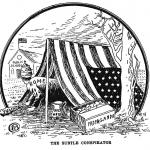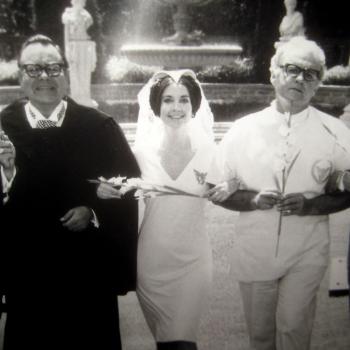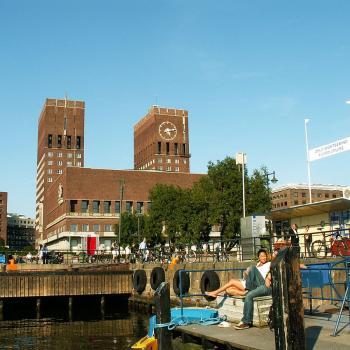The Council, in other words, attempted to fix a problem. It may have made matters worse in some ways, but it fought valiantly to better them in others. Just watch JFK’s requiem Mass if you’d like to see just how misguided, rushed, and sometimes irreverent pre-conciliar liturgies could be. And this is a televised Mass! Horror stories abound about less-well-publicized ones. As Pope Benedict put it in Summorum Pontificum, “the Second Vatican Council expressed the desire that the respect and reverence due to divine worship should be renewed and adapted to the needs of our time.” Vatican II failed in some respects, surely. It, however, gave thrust to the idea that we must return to reverence and respect in spite of modernity and the impulses it instills in us. Traditionalism is, in its own way, the heir to this tradition. It too goes too far in certain respects (I have seen some truly terrible behavior from online trads, some terrifically hateful talk), but its liturgical impulses remain sound; its supporters hope to reclaim respect for God in the liturgy. I do not always agree with the extent to which people push this principle. It cannot, however, be denied that it has a place—a place in the history of the Church since Vatican II.
Traditionalism’s beginning lies in the Council; ironically, so does its cultural cache. As seen above, shifts in our culture throughout the middle part of the last century (though with roots going back far longer and deeper) challenged religion. It became more difficult to stay put, to build a community, and thus to support a parish. Religion lost its preeminent place in society for a variety of reasons—perceived hypocrisy, a rising sense of the importance of individual choice, and a de-tethering of human beings from their pasts and traditions. In short, we see the rise of a consumeristic capitalism, a fundamental shift in culture attitudes (though, again, rooted in a much longer history).
This is precisely the sort of soil modern traditionalism needs to grow. In the contemporary world, our choices are felt to be individual, to be rooted only in our own desires. Even traditionalists speak this way; often they talk about how they can better nourish a relationship with God at the Latin Mass. Some note the importance of the older liturgy as a flagrant rejection of the excesses of modernity; its very use of Latin becomes a form of resistance. Whatever the precise reasons, we can note that each of these opinions signals participation in a specific subculture, something like a fandom or Twitter community. Only modernity could hope to offer people means to resist it from within it; only modernity could give one the choice of reaching into the past to mount this resistance. The Council, just as it called the Eastern Churches to return to their traditions, to emphasize their particularity, can be said to speak to this impulse in modern traditionalism. Pope Benedict acknowledges this in Summorum Pontificum:
The Supreme Pontiffs have to this day shown constant concern that the Church of Christ should offer worthy worship to the Divine Majesty, “for the praise and glory of his name” and “the good of all his holy Church.”
As from time immemorial, so too in the future, it is necessary to maintain the principle that “each particular Church must be in accord with the universal Church not only regarding the doctrine of the faith and sacramental signs, but also as to the usages universally received from apostolic and unbroken tradition. These are to be observed not only so that errors may be avoided, but also that the faith may be handed on in its integrity, since the Church’s rule of prayer (lex orandi) corresponds to her rule of faith (lex credendi).” [1]
Eminent among the Popes who showed such proper concern was Saint Gregory the Great, who sought to hand on to the new peoples of Europe both the Catholic faith and the treasures of worship and culture amassed by the Romans in preceding centuries. He ordered that the form of the sacred liturgy, both of the sacrifice of the Mass and the Divine Office, as celebrated in Rome, should be defined and preserved. He greatly encouraged those monks and nuns who, following the Rule of Saint Benedict, everywhere proclaimed the Gospel and illustrated by their lives the salutary provision of the Rule that “nothing is to be preferred to the work of God.” In this way the sacred liturgy, celebrated according to the Roman usage, enriched the faith and piety, as well as the culture, of numerous peoples. It is well known that in every century of the Christian era the Church’s Latin liturgy in its various forms has inspired countless saints in their spiritual life, confirmed many peoples in the virtue of religion and enriched their devotion.
In the course of the centuries, many other Roman Pontiffs took particular care that the sacred liturgy should accomplish this task more effectively. Outstanding among them was Saint Pius V, who in response to the desire expressed by the Council of Trent, renewed with great pastoral zeal the Church’s entire worship, saw to the publication of liturgical books corrected and “restored in accordance with the norm of the Fathers,” and provided them for the use of the Latin Church.
Among the liturgical books of the Roman rite, a particular place belongs to the Roman Missal, which developed in the city of Rome and over the centuries gradually took on forms very similar to the form which it had in more recent generations.
“It was towards this same goal that succeeding Roman Pontiffs directed their energies during the subsequent centuries in order to ensure that the rites and liturgical books were brought up to date and, when necessary, clarified. From the beginning of this century they undertook a more general reform.” [2] Such was the case with our predecessors Clement VIII, Urban VIII, Saint Pius X [3], Benedict XV, Pius XII and Blessed John XXIII.
In more recent times, the Second Vatican Council expressed the desire that the respect and reverence due to divine worship should be renewed and adapted to the needs of our time. In response to this desire, our predecessor Pope Paul VI in 1970 approved for the Latin Church revised and in part renewed liturgical books; translated into various languages throughout the world, these were willingly received by the bishops as well as by priests and the lay faithful. Pope John Paul II approved the third typical edition of the Roman Missal. In this way the Popes sought to ensure that “this liturgical edifice, so to speak … reappears in new splendour in its dignity and harmony.” [4]
In some regions, however, not a few of the faithful continued to be attached with such love and affection to the earlier liturgical forms which had deeply shaped their culture and spirit, that in 1984 Pope John Paul II, concerned for their pastoral care, through the special Indult Quattuor Abhinc Annos issued by the Congregation for Divine Worship, granted the faculty of using the Roman Missal published in 1962 by Blessed John XXIII. Again in 1988, John Paul II, with the Motu Proprio Ecclesia Dei, exhorted bishops to make broad and generous use of this faculty on behalf of all the faithful who sought it. (Summorum Pontificum)
There is much made here of the attachments people have to the Latin Mass, that is, much is made of their particular choices. History is plumbed for examples of previous popes allowing for particularity (which, in the post-Trent Church, was not always a good thing). The Latin Mass is offered not as a new norm, but as one liturgy among many. Just as Byzantine Churches use the Liturgies of St. John Chrysostom, St. Basil, and St. James, so does the Latin Church contain its own individuated liturgies. Traditionalism becomes, in a word, a consumer choice, a way for a specific group to manifest its anxieties and excitements through the form of certain devotions. These anxieties themselves, as I have shown, are rooted in those of Vatican II. History is full of such ironies!
I have not written this piece to be sly or to troll anyone. I believe it is worthwhile to acknowledge this history not least because it teaches us something about ourselves as a Church. Further, understanding this story of the past helps us to see how, if indeed many young people are turning to traditional devotions, they are doing so not (even if they do not realize this) in opposition to the Council, but rather in its spirit. If the Church is to survive in the modern world, it will need to be adaptive and particular. The Fathers of Vatican II understood this very well; indeed, they might smirk at seeing the Latin Mass become just another expression of the Faith, one executed with much more reverence and respect than its pre-conciliar version. Trads care more about the rubrics than their imagined forebears seem to have—and that is a good thing!
It is a good thing because we all should desire that the liturgy be respectful and humbling, that it invite us more deeply into prayer and awe at the loving, merciful, and just nature of the Lord. If we can learn to pray in this way—and to do so without hubris, without judgment, without too much attachment to outward devotions—Vatican II will have seen the fullness of its fruit.













